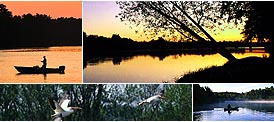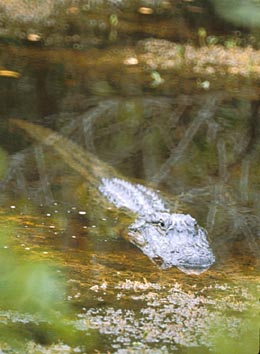
Note: Watch this area for additional navigation information in each section!


Everglades Reptiles and Amphibians
Reptiles and amphibians are animals whose body temperature changes with their surroundings (cold-blooded). Everglades National Park, with its semi-tropical climate, is an ideal home for these creatures. There are over fifty species of reptiles found in the park, including twenty-six snakes, sixteen turtles, and several lizards. The eighteen species of amphibians found in the park include the smallest frog in North America, the little grass frog. American Alligator This large reptile is the "king of the Everglades." Without the alligator, the Everglades might not survive. During the dry season (December through April), alligators dig out pockets, or holes, in the limestone. "Gator holes" are one of the few places in the park where there is standing water during the winter months. These holes become home to many insects, turtles, fish, and wading birds. During the summer wet season, these same animals are spread throughout the "river of grass." At one time an endangered species, the alligator is now making a come-back. They are common throughout the fresh water marshes of the park, and occasionally enter the brackish waters of Florida Bay. Despite their recovery, "gators" are still threatened. The biggest threat comes from artificially controlled water levels. Female alligators usually begin building nests in mid-June. The nest mounds are usually built on slightly higher banks, or on the edge of small tree islands called bayheads. If a lot of water is released into the park in late June, many of the nests flood and the developing eggs drown. The best time to see alligators in the park is during the winter dry season. At that time, they get together near the deeper water holes. All sizes and ages, from ten-inch babies to an occasional twenty-year-old, ten-foot-long adult, can be seen lounging on the bank along the Anhinga Trail. Alligators are critical to the survival of Everglades National Park. Without "gator holes," many animals would not make it through the winter dry season. Unless enough water is released at the right time of the year, alligators will not be around to create these "gator holes." Turtles Of the turtles found in the Park, most live in the fresh water marshes and ponds. The ones you are most likely to see include the striped mud turtle, common along the Anhinga Trail, the peninsula cooter, which is often seen at Shark Valley, and the Florida red-belly, found in fresh water marshes, ponds and solution holes. If you are walking on a trail through the pinelands or a hammock, and you see a turtle crawling along, it is probably a Florida box turtle. You may even come across one that has been fire-scarred or lost one of its legs. The only other land turtle found in the park is the gopher tortoise, and you are likely to see it only if you visit the most southwestern section of the park called Cape Sable. On Cape Sable, you might also see a diamondback terrapin basking along the shoreline. This species likes the brackish water of the mangrove estuary. At one time, turtles were quite common in the marine environment of Florida Bay. Today, there are fewer marine turtles because their nesting sites have been disturbed. Both the Atlantic hawksbill and the Atlantic ridley are endangered species. The Atlantic loggerhead, which commonly nests at night during the summer along Highland Beach at Cape Sable and Sandy Key in Florida Bay, is a nationally threatened species. If you are walking the beach at night and sight any one of these marine turtles nesting, do not disturb them, they are all protected species. Snakes Many of the snakes found in Everglades National Park are adapted to survive in the water. The striped crayfish snake is considered the best swimming snake in Florida, but you're not likely to see one unless you look carefully among the marsh plants in the northern part of the park. Much more common is the brown water snake which is the most frequently seen snake along the Anhinga Trail. People often mistake it for the poisonous Florida cottonmouth which is found in the same area. The water snake, if cornered or mistreated, will bite - but it is not poisonous. While most of the snakes living in or near the water are adapted to a fresh water environment, some, like the cottonmouth and mangrove salt marsh snake, can survive in the mangrove swamps and salt water marshes. Some of the snakes in the park are beautifully colored, standing out in their surroundings, while others are drab colored and blend in perfectly with their background. The brightly colored, very poisonous, eastern coral snake, with its red, yellow, and black rings and black snout, warns predators - "stay away from me, I'm dangerous." The black snout is the coral snake's most distinguishing feature. It is found in hardwood hammocks and pinelands under leaves, rocks, and logs. Both the scarlet and scarlet king snake imitate the coral snake in appearance and are found in the same habitat. All three species have red, black and yellow rings, but the scarlet and scarlet king have red snouts. Another difference is that in the coral snake, the red and yellow rings touch. The scarlet and scarlet king snakes have their red and yellow rings separated by black. Some of the most beautiful snakes in the park belong to a group called the rat snakes. The Everglades rat snake is brilliant orange with four dark stripes; the corn snake has reddish blotches with a black border in a background of grey, tan, yellow, or orange; and the common yellow rat snake has four black stripes on a bright golden yellow background. Unlike the bodies of most snakes which are rounded, the rat snakes are shaped like a loaf of bread. They are very good climbers and may be seen climbing a tree to get to eggs in a bird's nest. They also feed on small rodents, frogs, and toads, which they constrict or squeeze to death. Snakes are found in nearly every habitat in the Everglades. They range in size from the poisonous pygmy rattler, seldom more than two feet long (60 cm), to the threatened indigo snake, which can grow to be over eight feet long (2.4 m). Some are brilliantly colored, some may be poisonous, while others control the rodent population. Each one has an important role to play in the Everglades environment. Lizards The native green anole, which many of you know as the chameleon, was once very common throughout the park. Now, it is being gradually replaced in the pinelands and hardwood hammocks by the exotic brown anole which is native to Cuba. The Florida reef gecko is the only native gecko found in Florida. It is found in the hammocks and pinelands under rocks and leaves, and is the smallest lizard in North America (2 - 2-1/4 inches, or 5.4 cm). Inland glass lizards are common in fresh water marshes and pinelands that are flooded during certain times of the year. During high water and after fire, you may see them along roads that are next to their habitats. They may be up to two feet long (60 cm). Several exotic species of lizards have been able to adapt to the Everglades environment. These exotics often compete for food, shelter, and territory with native lizards. Many exotics are pets that have escaped or have been released into the Everglades. You can help protect the native lizards by not releasing exotic pets into the park. Amphibians Amphibians are animals who commonly spend the first part of their life in the water, breathing through gills. As adults, they may still live in the water but use lungs to breathe. They include frogs, toads, and salamanders. Many are common, but are more often heard than seen because they are out only at night (nocturnal) or are very well camouflaged. No more than 5/8" long (1.6 cm), the little grass frog is the tiniest frog in North America. Often, people think they are seeing a baby frog when they sight this species. It is found clinging to sawgrass a few feet above the water. Although it is seldom seen, you can hear its breeding choruses at night during the summer. The pig frog's grunt-like call can be heard night or day, year round, at the Anhinga Trail and Shark Valley. It is found through-out the fresh water marshes of the park. The Everglades dwarf siren is a salamander known to be found only in the Everglades. When a plant or animal is found in only one particular place in the world, scientists say it is endemic to that place. If you come to Everglades National Park's Main Visitor Center during the summer, you are likely to hear large choruses of oak toads. They are found in hammocks, pinelands, and wet sawgrass communities and are often active during the day. Everglades National Park has many interesting reptiles and amphibians. Each one has an important role to play in the environment.












